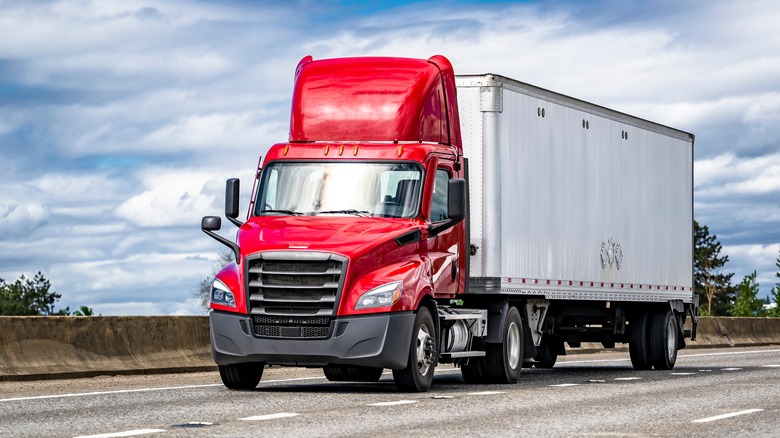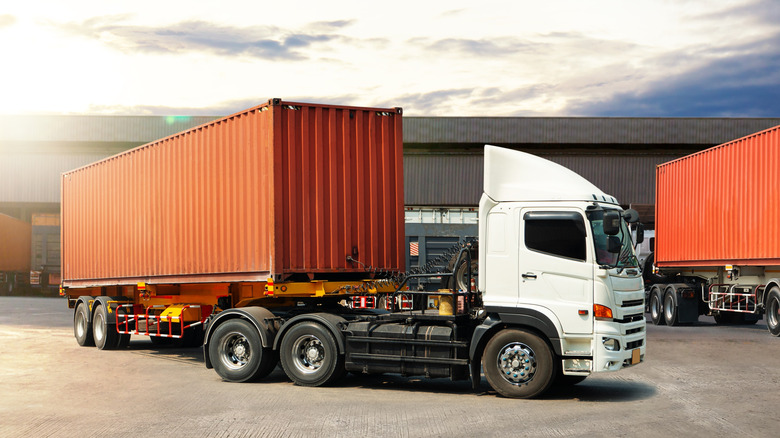What Is The Spoiler On Semi-Truck Hoods Called And How Does It Work?
You might have seen a semi-truck with a giant spoiler perched atop its cab and wondered what that large panel was for. Although these features look similar to spoilers and are also there to help with aerodynamics, they're not spoilers like the ones on muscle and sports cars. A spoiler is designed to create drag and produce downforce, which increases cornering grip and stability at high speeds.The additional drag from a spoiler makes a performance car 'stick' to the road better, but on a semi-truck these panels are known as wind deflectors, roof fairings, or cab air deflectors. Wind deflectors are designed to do the opposite of what a spoiler does; reduce drag by making a rig more streamlined.
The square contours of a trailer's leading edge don't cut smoothly through the wind, so the roof-mounted fairings are there to guide air over and around the trailer and reduce the turbulence generated in the gap between tractor and trailer. As a semi-truck barrels down the highway it displaces a massive amount of air, creating a high pressure zone in front of the cab and a swirling low-pressure wake behind it. That pressure difference is called form drag, and the resistance it generates requires 85% of a truck's energy to overcome.
How semi-truck wind deflectors work
Without a wind deflector, form drag would cause excessive fuel consumption and instability at high speeds. Smoothing the airflow over the cab-to-trailer gap with a wind deflector is an important tactic that keeps long-haul trucking safer and more fuel efficient. A wind deflector works as a passive flow control device, directing incoming air over the top and around the sides of the trailer. The design is simple yet effective in managing turbulent air in the gap between the cab and trailer. It does this by channeling airflow upward and outward so that less of it collides with the trailer's blunt front face.
This fluid dynamics tweak also helps air flow more cohesively from the tip to tail of a semi. According to the U.S. Department of Energy's Argonne National Laboratory, aerodynamic drag consumes approximately 21.3% of the total energy used by a Class 8 truck traveling at 65 mph. By reshaping airflow, a roof fairing recovers a portion of that loss. The EPA's SmartWay program has verified that properly designed fairings can improve fuel efficiency by more than 5%, potentially saving operators thousands of dollars per truck each year.
Aerodynamic panels work better in tandem
The presence of a wind deflector improves a tractor-trailer's aerodynamics quite a bit, but there are other add-ons that can help even more. Full aerodynamic packages that combine wind deflectors with side skirts and boat tails deliver the best results by shaping airflow around other trouble spots. In a 2015 study by Transport Canada and the National Research Council, researchers found that side skirts along the bottom of a trailer cut fuel usage by 10%. For a rig that covers about 20,000 miles a year this saves 761 gallons of fuel and reduces carbon emissions by more than 19,000 pounds.
The study also examined the effects of height differences and various gaps between the cab and trailer, using fairings in other spots on the trailer, and rounding off a trailer's edges. Tapered trailer edges, side skirts, and a boat tail together with a roof fairing cut wind resistance by a whopping 27%, far more than any one tactic alone. Boat tail fins connected to various types of semi-trailers cut drag 6–7% alone while saving over 500 gallons of fuel and 1,100 pounds of CO₂ yearly. While these individual measures offer modest improvements, comprehensive strategies unlock next-level efficiency gains for commercial trucking fleets.


